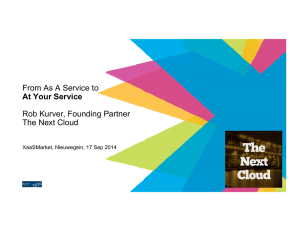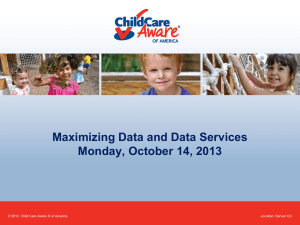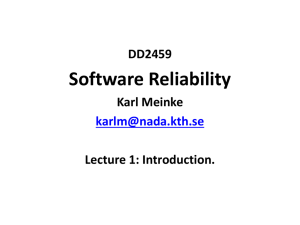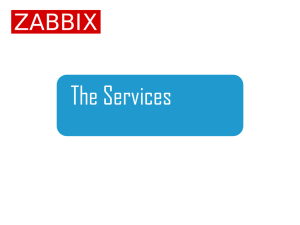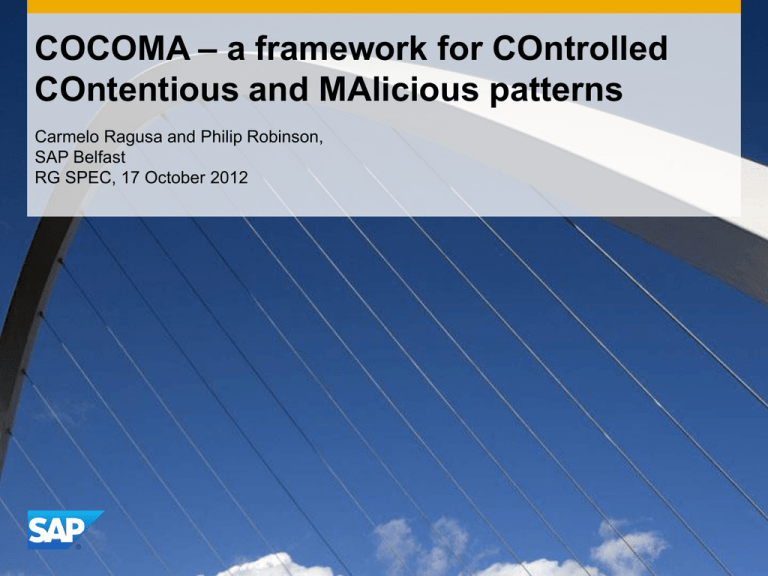
COCOMA – a framework for COntrolled
COntentious and MAlicious patterns
Carmelo Ragusa and Philip Robinson,
SAP Belfast
RG SPEC, 17 October 2012
The General Business Problem of Software Testing
• Testing is Expensive (30 – 50% of Budget [1])
• …but so are bugs [2]
[1] M-C. Ballou, "Improving Software Quality to Drive Business Agility", IDC Survey and White Paper (Sponsored by Coverity Inc.), 2008
[2] B. Gauf, E. Dustin, "The Case for Automated Software Testing", Journal of Software Technology, v.10, n.3, October 2007
© 2012 SAP AG. All rights reserved.
2
Using the Cloud for testing, but what does it mean?
Different flavours:
In-cloud testing:
Performed inside a cloud to ensure the quality of the services
offered by the cloud infrastructure itself
Cloud for testing:
Using the cloud to create a critical mass of users/traffic towards a
System Under Test
Over-cloud testing:
To ensure the quality of the end-to-end cloud-application over the
cloud
© 2012 SAP AG. All rights reserved.
3
Difficult to decide!
?
?
© 2012 SAP AG. All rights reserved.
4
What do we want then?
Our research questions, when executing testing of a SuT in a cloud
infrastructure, are the following:
• How can we assess the platform where tests are carried out?
• How can we compare the different platforms where we can carry out our tests?
• Which infrastructure pattern to carry out our tests is more effective for our SuT
specific needs?
SAP is partner in BonFIRE*, FP7 project: A multi-site cloud facility for
applications, services and systems research and experimentation
SAP was in charge of one of the native experiments (concluded in May 2012),
Effective Cloud software testing
* Acknowledgment: The BonFIRE project has received research funding from the EC's Seventh Framework Programs (EU ICT-2009-257386 IP under
the Information and Communication Technologies Program).
© 2012 SAP AG. All rights reserved.
5
What we have done so far
We derived a set of criteria for assessing and comparing the effectiveness
of platforms and infrastructure patterns for supporting cloud software testing:
Identified an initial set from preliminary studies published in [3]:
–
–
–
–
–
–
–
Cost-effectiveness
Simplicity
Target representation
Observability
Controllability
Predictability
Reproducibility
Extended and refined from conducting our experiment in BonFIRE:
– Availability
– Reliability
– Reproducible environment conditions
[3] Robinson, P. and Ragusa, C. (2011) "Taxonomy and Requirements Rationalization for Infrastructure in Cloud-based Software Testing", Proceedings
of the IEEE International Conference and Workshops on Cloud Computing Technology and Science (CloudCom)
© 2012 SAP AG. All rights reserved.
6
Reproducing environment conditions
•
How can we create/manage/control reproducible environment conditions?
•
In what environment conditions are we interested?
•
•
•
Contentiousness
Maliciousness
Faultiness
COntrolled COntentious and MAlicious patterns => deliberately make the
platform “misbehave” – contention, faults and attacks
Software
Unknown
Cloud
Infrastructure
© 2012 SAP AG. All rights reserved.
7
Approach: Effect Emulation versus Cause Emulation
State of the art: Cause
Emulation in SW Testing (e.g.
Create instances of colocated
workloads)
Load
SuT
1 2 3
*
1 2 3
*
Test Environment
© 2012 SAP AG. All rights reserved.
COCOMA Approach: Effect
Emulation in SW Testing (e.g.
Emulate resource effects of
colocated workloads)
1
Load
SuT
COCOMA
1
2
3
*
Test Environment
8
Use case: COCOMA walkthrough in BonFIRE
•
•
•
•
•
From RESTfully client
• Deploy SuT, Zabbix and
COCOMA
• Create emulation
From COCOMA
• Create a distribution
• Schedule runs of the
distribution
• Send metrics values to Zabbix
Start Load to SuT
From RESTfully client
• Manage emulation
• Check status
• Delete
• …
From COCOMA
• Emulation Logs are saved
RESTfully
script
Load
SuT
Create
emulation
Z
a
b
b
i
x
Check
emulation
Emulation
Distribution
1
2 COCOMA
3
*
BonFIRE Onrequest
© 2012 SAP AG. All rights reserved.
9
Distributions in COCOMA
Contentious
• Target resources
•
•
•
•
CPU
RAM
I/O
Network
• Patterns
•
•
•
•
Linear
Poisson
…
Cloud specific
Malicious
• Privileges
•
•
•
•
•
• Payloads
•
•
•
•
•
© 2012 SAP AG. All rights reserved.
Browse/listen
Basic user
Advanced user
Admin user
Owner
Snoop/scan
Read
Alter
Deny/damage
Control
10
COCOMA Design
Emulation Management
Query/feedback
emulationManager
ccmsh/
REST API
distributionManager
aggregator
distribution<Type>Instance
emulationLifetimeInstance
scheduler
Decision & orchestration
run
probeInstance
run
SuT
COCOMA
Secondary/aggregator monitoring
probeInstance
Stressapptestrun
probeInstance
run
Control & actuation
Primary/direct monitoring
Test Environment
© 2012 SAP AG. All rights reserved.
11
Benefits in adopting COCOMA
•
Experimenters will be able to
•
•
•
•
•
study their system under real world effects conditions
control those conditions
correlate distributions and performances/results of their system under test
use those findings to discover weaknesses and tune/enhance their system
COCOMA will be released as open source under Apache v2 license
•
We envisage new distributions contributions to the framework
•
•
•
Ideally “common” cloud patterns which can be validated and afterwards used by other
experimenters
Easy integration within an existing infrastructure
Ability to create and reproduce complex experimental scenarios
© 2012 SAP AG. All rights reserved.
12
Potential Stakeholders
•
Cloud Service Providers
•
•
Cloud Application Administrators
•
•
E.g. Enhance cloud application management with platform assessment
Application Developers and Testers
•
•
E.g. Enhance cloud management with infrastructure assessment
E.g. Contributing to PaaS application testing best-practices
Benchmarks and Standards Groups
•
E.g. Possible contribution to validation of cloud usage patterns (SPEC – RG Cloud WG)
© 2012 SAP AG. All rights reserved.
13
Thank You!




